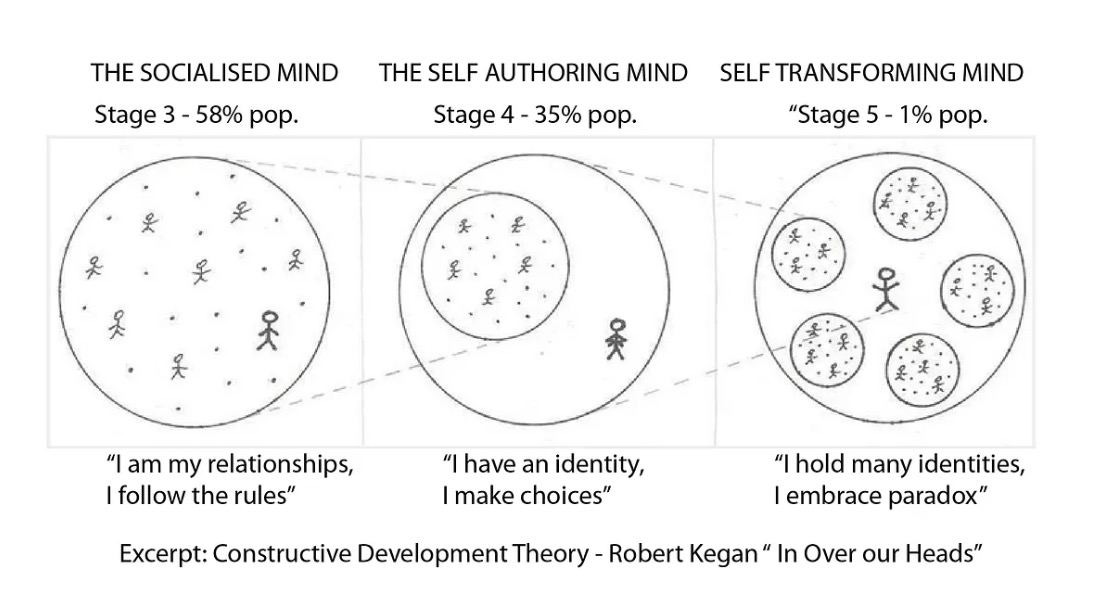integral theory figuring space
as your awareness expands, so does your psychological development
“I also struggle to explain it, so let me bubble out something in here to exercise the skill,” I messaged to Integral Youth community chat in midst of our collective realization that uh, explaining this diagram is not an easy task!
As such, let’s travel to the moment of your birth. As a newborn, you are full of Not Yets - your feet muscles aren’t yet strong enough to take you up, the neurons aren’t yet wired enough to make you speak “mama,” your memory systems aren’t yet well-formed to make you predict what’s next.1
The world is in a state of high entropy—a swirling, unstructured flood of sensations, waiting to be shaped into patterns, waiting for labels to be assigned to stimuli.
The more you fall, the more you learn. Around twelve months later you fell enough times to recognize that the Object in the mirror is you. You can manipulate this Object, raising its tiny fingers to touch the glass. The idea of Self emerges in your awareness, and soon, you begin to see yourself as a Subject that acts, a Subject that leaves marks on a mirror, a Subject with its own “I.”
Congratulations, baby human, there is so much you can unfold this “I” into.
Some years later, you blow out the candles for your third birthday of Self-existence—and with it, you receive a gift of a brand-new bucket with colorful spades. Building sand castles with your first-ever bestie Alice is a pure joy, until suddenly, you burst into tears —your favorite red spade is missing!
You drop to all fours, digging through the sand while tearing a waterfall of desperation until Alice proclaims, “here is your spade!”
What did just happen? You freeze. Why did she do it? That’s your spade - why did she take it?
And it in this sandbox that you realize - Alice didn’t know the spade was yours, she didn’t share the memory of candle-blowing. She has her own mind distinct from yours — she is her own Self.
Congratulations, kiddo human, you just expanded your Awareness. Now not only it includes an “I”, or Subject that acts, but also other Subjects of their own kinds. 2
Fast forward to eighth grade, you find yourself in Science class and oh wow—turns out you can model the sand! The way grains shift, pile, and collapse isn’t random; it follows precise physical laws. Gravity, friction, and even tiny water bridges between grains determine whether a sandcastle holds or crumbles.
You are mesmerized by the elegance of equations—E = mc², Newton’s laws, wave functions—so much so that you hop on a train of objective truth seeking while watching the West glorify science as the ultimate wealth-making mechanism.
“What if I publish half-baked writing and edit it later?” Svitlana thinks.
Experiment around and find out.
Edits to finish this up are in the baking!
Meantime, welcome to the chaos of unedited outline.
Years later, you and Alice, now high schoolers, eagerly act on the newly discovered biochemistry pulling you toward each other. The night unfolds with passion—you both experience the same physics: the friction of skin, the shared warmth, the way your bodies align so effortlessly. This interaction, too, must be governed by the same universal laws, right?
Oh well. If the world were just an equation, then Alice and you would have experienced the same night, the same discovery of each others “the ones”, the same alignment on the kiddo-friends-turn-family story.
Equations are not the territory.
[Continue HERE] Alright, see the same world as you do, physics and mathematics after all. But no, turns out your memories and sensitivities condition your way of seeing. We aren’t experiencing the same reality — we are each constructing worlds atop the physical fabric of existence. The idea of plurality of opinions emerges, yes-anding the objective with subjective, intersubjective, and interobjective. Yes, multitudes can co-exist.
Equations is not the territory.
Thoughts about thought, meta thoughts.
this too is on the <self me and self you> level. now imagine if you see groups of people, e.g. american democrats, as a collective self of a kind with its awareness and perceptions.
at some point, you might realize that it is all just a huge intertwingled eco-system, and what i do today influences how a kid feels in ukraine. so is there much separation between you vs me? you vs a kid in ukraine?
you start seeing that maybe there are less bounds between individuals, you *integrate* others into the concept of self and start seeing that.
welcome to the world of non-duality.
you are me
i am you
and we are the world
and perhaps.. it isn't just about human beings, perhaps its about any beings, like maybe rock too is a being of a kind?3 everything everywhere all at once. is you.
Huggingly,
Svitlana
P.s: I welcome your pokes and challenges.
P.s.s.: It has been a gift to have a deeply knowledgeable guide in this journey. Thank you Victor.
media for your curious rabbit hole
Michael Levin’s research challenges the rigid separation between self and other, mind and body, by showing that every cell—yours, mine—is intelligent and conscious in its own way, collectively shaping the larger organism of existence. Life is interconnected non-dual system, is it?
A human bean explaining spiral dynamics with Social Mathematics diagrams.
An are.na collection of media, memes and whatnot.
Robin’s Carhart-Harris (aka leading psychedelic researcher) explains how level of entropy in your brain shapes two states of consciousness. Also my notes on the paper itself.
If Bayesian modeling married Non-duality and had a baby theory
Your active inference isn’t yet active:)) The perceptron is learning!
Curious rabbit hole invitation for you: Principles of Vasocomputation: A Unification of Buddhist Phenomenology, Active Inference, and Physical Reflex.
Theory of mind refers to the capacity to understand other individuals by ascribing mental states to them. A theory of mind includes the understanding that others' beliefs, desires, intentions, emotions, and thoughts may be different from one's own. Thanks, Wikipedia!
hi michael levin
















lmk if you want to run some event/schelling point on these topics? https://chrislakin.blog/p/how-do-parts-form-a-whole
That scene from EEAAO is perfection.